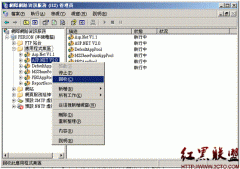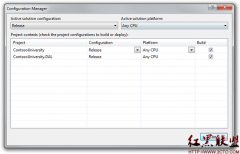asp.net:百万级以上的数据处理
来源:未知 责任编辑:责任编辑 发表时间:2014-05-26 11:00 点击:次
处理百万级以上的数据提高查询速度的方法:
1.应尽量避免在 where 子句中使用!=或<>操作符,否则将引擎放弃使用索引而进行全表扫描。
2.对查询进行优化,应尽量避免全表扫描,首先应考虑在 where 及 order by 涉及的列上建立索引。
3.应尽量避免在 where 子句中对字段进行 null 值判断,否则将导致引擎放弃使用索引而进行全表扫描,如:
select id from t where num is null
可以在num上设置默认值0,确保表中num列没有null值,然后这样查询:
select id from t where num=0
4.应尽量避免在 where 子句中使用 or 来连接条件,否则将导致引擎放弃使用索引而进行全表扫描,如:
select id from t where num=10 or num=20
可以这样查询:
select id from t where num=10
union all
select id from t where num=20
5.下面的查询也将导致全表扫描:(不能前置百分号)
select id from t where name like ‘%abc%’
若要提高效率,可以考虑全文检索。
6.in 和 not in 也要慎用,否则会导致全表扫描,如:
select id from t where num in(1,2,3)
对于连续的数值,能用 between 就不要用 in 了:
select id from t where num between 1 and 3
8.应尽量避免在 where 子句中对字段进行表达式操作,这将导致引擎放弃使用索引而进行全表扫描。如:
select id from t where num/2=100
应改为:
select id from t where num=100*2
9.应尽量避免在where子句中对字段进行函数操作,这将导致引擎放弃使用索引而进行全表扫描。如:
select id from t where substring(name,1,3)=’abc’–name以abc开头的id
select id from t where datediff(day,createdate,’2005-11-30′)=0–’2005-11-30′生成的id
应改为:
select id from t where name like ‘abc%’
select id from t where createdate>=’2005-11-30′ and createdate<’2005-12-1′
10.不要在 where 子句中的“=”左边进行函数、算术运算或其他表达式运算,否则系统将可能无法正确使用索引。
11.在使用索引字段作为条件时,如果该索引是复合索引,那么必须使用到该索引中的第一个字段作为条件时才能保证系统使用该索引,否则该索引将不会被使 用,并且应尽可能的让字段顺序与索引顺序相一致。
12.不要写一些没有意义的查询,如需要生成一个空表结构:
select col1,col2 into #t from t where 1=0
这类代码不会返回任何结果集,但是会消耗系统资源的,应改成这样:
create table #t(…)
13.很多时候用 exists 代替 in 是一个好的选择:
select num from a where num in(select num from b)
1.应尽量避免在 where 子句中使用!=或<>操作符,否则将引擎放弃使用索引而进行全表扫描。
2.对查询进行优化,应尽量避免全表扫描,首先应考虑在 where 及 order by 涉及的列上建立索引。
3.应尽量避免在 where 子句中对字段进行 null 值判断,否则将导致引擎放弃使用索引而进行全表扫描,如:
select id from t where num is null
可以在num上设置默认值0,确保表中num列没有null值,然后这样查询:
select id from t where num=0
4.应尽量避免在 where 子句中使用 or 来连接条件,否则将导致引擎放弃使用索引而进行全表扫描,如:
select id from t where num=10 or num=20
可以这样查询:
select id from t where num=10
union all
select id from t where num=20
5.下面的查询也将导致全表扫描:(不能前置百分号)
select id from t where name like ‘%abc%’
若要提高效率,可以考虑全文检索。
6.in 和 not in 也要慎用,否则会导致全表扫描,如:
select id from t where num in(1,2,3)
对于连续的数值,能用 between 就不要用 in 了:
select id from t where num between 1 and 3
8.应尽量避免在 where 子句中对字段进行表达式操作,这将导致引擎放弃使用索引而进行全表扫描。如:
select id from t where num/2=100
应改为:
select id from t where num=100*2
9.应尽量避免在where子句中对字段进行函数操作,这将导致引擎放弃使用索引而进行全表扫描。如:
select id from t where substring(name,1,3)=’abc’–name以abc开头的id
select id from t where datediff(day,createdate,’2005-11-30′)=0–’2005-11-30′生成的id
应改为:
select id from t where name like ‘abc%’
select id from t where createdate>=’2005-11-30′ and createdate<’2005-12-1′
10.不要在 where 子句中的“=”左边进行函数、算术运算或其他表达式运算,否则系统将可能无法正确使用索引。
11.在使用索引字段作为条件时,如果该索引是复合索引,那么必须使用到该索引中的第一个字段作为条件时才能保证系统使用该索引,否则该索引将不会被使 用,并且应尽可能的让字段顺序与索引顺序相一致。
12.不要写一些没有意义的查询,如需要生成一个空表结构:
select col1,col2 into #t from t where 1=0
这类代码不会返回任何结果集,但是会消耗系统资源的,应改成这样:
create table #t(…)
13.很多时候用 exists 代替 in 是一个好的选择:
select num from a where num in(select num from b)
相关新闻>>
最新推荐更多>>>
- 发表评论
-
- 最新评论 进入详细评论页>>



